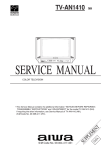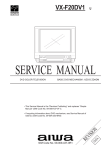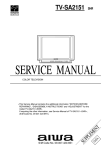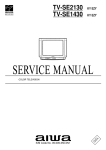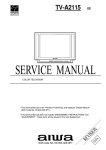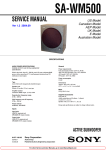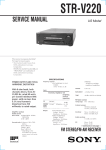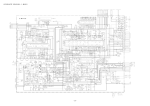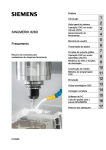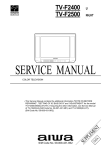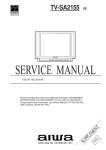Download Aiwa TV-CN202 Service manual
Transcript
TV-CN202 NH1C3 SERVICE MANUAL COLOR TELEVISION S/M Code No. 09-995-333-9R1 DA TA RE VI SIO N This Service Manual is the "Revision Publishing" and replaces "Simple Manual" (S/M Code No. 09-995-333-9T1). SPECIFICATIONS Category: TV Broadcasting System: Channel Coverage: Color television NTSC-M TV: 2 – 69 Cable (CATV): 5A, 2 – 13,A-5 – A-1, A–W, W+1 – W+84 (A-8) Number of Preset Channels 181 Aerial Input 75 ohms, unbalanced Picture Tube 20” (510 mm) Screen Size 404 (W) x 303 (H) x mm (16 x 12 in.) 480 mm (diagonal) (19 in.) Video Input/Output 1 Vp-p, 75 ohms Audio Input 0.5 Vrms., 33 k ohms more Audio Output 0.5 Vrms., 2.2 k ohms less Speaker 76 mm (3 in.) round: 2 Operating Voltage 110 – 240 V AC, 50/60 Hz Power Consumption 85 W Earphone Jack Operating Temperature Operatin Humidity Dimensions Weight •Design and specifications are subject to change without notice. ACCESSORIES LIST REF. NO 1 2 3 4 Mini jack 5°C – 40°C 35% – 80% 520 (W) x 479.5 (D) x 425 (H) mm (20 1/2 x 19 x 16 3/4 in.) 18 kg (39.6 lbs.) PART NO. KANRI DESCRIPTION NO. 87-JBG-902-010 IB,NH (E) -CN202/142 -M 87-JBG-953-010 RC UNIT,RC-7VT02 87-B30-136-010 ANT ASSY,TV 5 SEC ( NTSC) 87-A90-786-010 PLUG,CONVERSION IR46 2 DISASSEMBLY INSTRUCTIONS 1. HIGH-VOLTAGE CAP (ANODE CAP) REMOVAL Anode cap 1-1. Cautions before Removing CRT GND Discharge the anode voltage (1) The anode voltage is not discharged completely from the CRT of this unit even after the power is turned off. Be sure to discharge the residual anode voltage before removing the anode cap. Do not use pliers (2) Do not use pliers, etc. to remove the anode cap. If you used pliers and bent the hook to remove the cap, the spring characteristics of the hook could be lost, and when reinstalled, the cap would come off from the CRT anode button easily, causing an accident. Do not turn the anode cap (3) If the anode cap is turned in the direction of its circumference, the hook is likely to come off. Grip 1-2. Anode Cap Removal (1) (2) (3) (4) CRT Hook CRT GND Fig. 1 Discharge the anode voltage. (See Figure 1) Connect a flat-bladed screwdriver to the CRT GND via an alligator clip. Use a tester to check the end of the screwdriver and ground of the TV for continuity. Touch the hook with the end of the screwdriver. Caution : Be careful not to damage the anode cap. Anode cap Turn over the anode cap. Caution : Be careful not to damage the anode cap. CRT Anode button Hook Fig. 2 (5) Push the anode cap with your thumb in the direction of arrow 1 as shown in the figure, then lift the cap in the direction of arrow 2 to release the hook on one side. (See Figure 3) 1 2 Anode cap 1 CRT CRT Hook Hook Fig. 3 Anode cap (6) Turn over the anode cap on the side where the hook was released and pull out the cap in the direction opposite to that on which the cap was pushed. (See Figure 4) Caution : Do not pull out the anode cap straight up. : Do not pull the cap forcibly. After removing the cap, check that the hook is not deformed. Pull out CRT Anode button Hook Fig. 4 4 2. ANODE CAP REINSTALLTION Anode cap Observe the cautions carefully so that no accident occurs due to a defect in installing the anode cap and so it does not come off. Left Right 2-1. Caution before Reinstalling Never turn the anode cap after installing it Never re-use the hook when it has been deformed (1) (2) If the anode cap is turned after it is installed, it may come off. Therefore, arrange the high-voltage cable before attaching the anode cap. (See Figure 1-1) If you have attached the anode cap before arranging the high-voltage cable, arrange the cable carefully so the cap does not turn. Fig. 1-1 Anode button 2-2. Anode cap reinstallation (1) (2) Installation section Use a clean cloth moistened slightly with alcohol to clean the installation section. (See Figure 2) Caution : Check that the installation section is free from dust, foreign matter, etc. Coat the anode cap installation circumference with an appropriate amount of the specified silicone grease (KS-650N). (See Figure 2) Caution : Be careful that silicone grease does not enter the anode button. Fig. 2 High-voltage cable Anode cap (3) Eliminate twisting, etc. of the high-voltage cable and arrange it so that no twisting occurs. (See Figure 3) Caution : If the cable is not arranged correctly, the anode cap could turn and cause an installation defect. Fig. 3 5 (4) Turn over the rubber cap symmetrically on the left and right. (See Figure 4) Caution : Take great care not to damage the anode cap. Fig. 4 (5) (6) (7) Fit your forefinger over the projection at the center of the cap and hold the cap between your thumb and middle finger. (See Figure 5-1) Apply the hook on one side to the anode button as shown on the figure. (See Figure 5-2) Caution : Check that the hook is held securely. Apply the hook on the other side to the anode button as shown in Figure 5-3. Fig. 5 Anode button Hook Hook 30˚ Anode button Anode button Fig. 5-2 Hook Fig. 5-3 6 (8) (9) (10) (11) Pull the anode cap slightly with the rubber cap turned over and visually check that the hook is engaged securely. Release your hand from the rubber cap of the anode cap. Caution : Cover the anode cap so that it does not lift. Hold the skirt of the andoe cap slightly to improve the close contact between the cap and CRT. Check that the anode cap is in close contact with the CRT. (See Figure 6) Anode cap Skirt Fig. 6 Front cabinet 3. CASE REMOVAL 3-1. Rear Cabinet Removal (See Figure 1) 1 (1) Remove four screws 1 and three screws 2, then remove the rear cabinet in the direction of the arrow. 1 1 2 2 2 1 Rear cabinet Fig. 1 Front cabinet 3-2. Neck C.B. (PWB, NK) Removal (See Figure 2) (1) (2) Disconnect CN903 (CRT GND). Remove the Neck C.B. in the diection of arrow 1. CN801 (Degauss cord) 3-3. Main C.B. (PWB, MAIN) Removal (See Figure 2) (1) (2) (3) 1 Remove connector (CN401). Remove connector (CN801). Pull out the Main C.B. in the direction of the direction of arrow 2. PWB, NK 7 CN903 PWB, MAIN 2 CN401 (Speakers) ELECTRICAL MAIN PARTS LIST REF. NO PART NO. KANRI NO. DESCRIPTION REF. NO IC 87-JBC-629-010 87-A90-297-010 87-A20-612-010 87-A20-611-080 87-A20-362-010 IC,M37272M8-131SP RCR UNIT,SBX1981-52 IC,AT93C46-10PI IC,M51943BSL-700A IC,LA7676 D 87-A20-364-010 87-A20-734-010 87-002-577-010 87-001-647-080 87-002-524-010 IC,KIA7809PI IC,TDA2007A IC,LA7953N IC,NJM78L 12A IC,LA7837 87-017-956-010 87-A20-980-010 87-020-881-080 IC,BA7611AN IC,STR-S6707N IC,NJM78L05A TRANSISTOR 87-A30-091-080 89-111-755-080 89-327-854-080 89-337-794-580 87-A30-090-080 FET,2SJ460 TR,2SA1175F TR,2SC2785F TR,2SC3779 D/E FET,2SK2541 87-A30-095-010 89-334-674-580 87-A30-041-010 87-A30-005-010 TR,2SD2333LS/C202 TR,2SC3467 D/E TR,SE115N TR,2SC2688M/L 87-070-345-080 87-070-150-080 87-070-274-080 87-A40-286-080 87-A40-004-080 DIODE,IN4148 ZENER,MTZJ33D DIODE,1N4003 SEM DIODE,RGP10JE-5025 ZENER,MTZJ16A 87-017-654-060 87-A40-450-090 87-A40-354-090 87-A40-440-080 DIODE,GBU6J DIODE,RU 1P DIODE,UF3GL-6251 ZENER,MTZJ7.5A BT301 BT403 BT601 C1 C2 87-JBC-625-010 87-JBC-624-010 87-JBC-626-010 87-016-624-080 87-018-119-080 CONN ASSY,5P V WHT TV-NK CONN ASSY,9P V JK CONN ASSY,4P V WHT TV-NK CAP,E 10-16 SSL CAP, CER 100P-50V C3 C4 C5 C6 C9 87-018-134-080 87-016-633-080 87-016-583-080 87-018-134-080 87-018-128-080 CAPACITOR,TC-U 0.01-16 CAP,E 1-50 SSL CAP,E 100-25 SSL CAPACITOR,TC-U 0.01-16 CAP, CERA-SOL SS 560P C10 C11 C12 C13 C14 87-018-131-080 87-016-633-080 87-018-209-080 87-018-109-080 87-018-109-080 CAP, CER 1000P-50V CAP,E 1-50 SSL CAP, CER 0.1-50V CAP, CER 22P-50V CAP, CER 22P-50V C15 C16 C17 C18 C19 87-018-109-080 87-018-109-080 87-018-109-080 87-018-109-080 87-018-131-080 CAP, CAP, CAP, CAP, CAP, C21 C22 C23 C25 C26 87-016-637-080 87-016-633-080 87-016-637-080 87-016-633-080 87-018-209-080 CAP,E 10-50 SSL CAP,E 1-50 SSL CAP,E 10-50 SSL CAP,E 1-50 SSL CAP, CER 0.1-50V C29 C101 C102 C103 87-018-123-080 87-016-636-080 87-018-134-080 87-016-575-080 CAP, CER 220P-50V CAP,E 4.7-50 SSL CAPACITOR,TC-U 0.01-16 CAP,E 220-16 SSL DIODE PART NO. KANRI NO. DESCRIPTION C105 C106 C107 C203 C204 87-016-637-080 87-018-134-080 87-A10-207-080 87-018-134-080 87-018-134-080 CAP,E 10-50 SSL CAPACITOR,TC-U 0.01-16 CAP,TCS 0.01-50KBUP050 CAPACITOR,TC-U 0.01-16 CAPACITOR,TC-U 0.01-16 C205 C207 C208 C210 C211 87-018-134-080 87-016-632-080 87-018-131-080 87-018-134-080 87-A10-585-080 CAPACITOR,TC-U 0.01-16 CAP,E 0.47-50 SSL CAP, CER 1000P-50V CAPACITOR,TC-U 0.01-16 CAP,CER 18P-50 J CH C214 C215 C216 C218 C219 87-018-134-080 87-016-637-080 87-018-134-080 87-016-583-080 87-018-134-080 CAPACITOR,TC-U 0.01-16 CAP,E 10-50 SSL CAPACITOR,TC-U 0.01-16 CAP,E 100-25 SSL CAPACITOR,TC-U 0.01-16 C301 C302 C303 C305 C306 87-016-583-080 87-016-632-080 87-018-134-080 87-016-583-080 87-018-134-080 CAP,E 100-25 SSL CAP,E 0.47-50 SSL CAPACITOR,TC-U 0.01-16 CAP,E 100-25 SSL CAPACITOR,TC-U 0.01-16 C309 C312 C314 C315 C316 87-016-634-080 87-016-637-080 87-018-125-080 87-016-632-080 87-016-633-080 CAP,E 2.2-50 SSL CAP,E 10-50 SSL CAP, CER 330P-50V CAP,E 0.47-50 SSL CAP,E 1-50 SSL C319 C320 C321 C322 C323 87-018-130-080 87-016-627-080 87-016-634-080 87-016-633-080 87-016-636-080 CAP,TC-U 820P-50 B CAP,E 47-16 SSL CAP,E 2.2-50 SSL CAP,E 1-50 SSL CAP,E 4.7-50 SSL C325 C326 C327 C328 C329 87-018-134-080 87-018-113-080 87-016-633-080 87-018-115-080 87-016-637-080 CAPACITOR,TC-U 0.01-16 CAP, CER 33P-50V CAP,E 1-50 SSL CAP, CER 47P-50V CAP,E 10-50 SSL C330 C331 C332 C333 C334 87-018-194-080 87-018-111-080 87-018-134-080 87-018-115-080 87-018-134-080 CAP,TC-U 91P-50 B CAP,TC-U 27P-50 B CAPACITOR,TC-U 0.01-16 CAP,TC-U 47P-50 B CAPACITOR,TC-U 0.01-16 C336 C337 C401 C403 C405 87-018-134-080 87-018-134-080 87-016-586-080 87-016-586-080 87-A10-776-080 CAPACITOR,TC-U 0.01-16 CAPACITOR,TC-U 0.01-16 CAP,E 470-25 SSL CAP,E 470-25 SSL CAP,E 1000-25 M 105 KMG C406 C407 C408 C412 C414 87-016-621-080 87-016-621-080 87-016-627-080 87-016-633-080 87-016-637-080 CAP,E CAP,E CAP,E CAP,E CAP,E 220-10 SSL 220-10 SSL 47-16 SSL 1-50 SSL 10-50 SSL C418 C422 C423 C424 C425 87-016-583-080 87-016-636-080 87-A10-831-080 87-016-632-080 87-016-632-080 CAP,E CAP,E CAP,E CAP,E CAP,E 100-25 SSL 4.7-50 SSL 1000-25 M SMG 0.47-50 SSL 0.47-50 SSL C426 C427 C501 C504 C505 87-016-637-080 87-016-586-080 87-016-583-080 87-016-591-080 87-016-641-080 CAP,E CAP,E CAP,E CAP,E CAP,E 10-50 SSL 470-25 SSL 100-25 SSL 100-35 SSL 100-50 SSL C506 C507 C508 C509 C511 87-A10-367-080 87-A10-402-080 87-016-634-080 87-016-587-090 87-018-123-080 CAP,CER 10P-500 J SL CAP,M 0.22-100 J TF TYPE1 CAP,E 2.2-50 SSL CAP,E 1000-25 M SSL CAP, CER 220P-50V C601 C602 C603 C604 C605 87-016-596-080 87-016-635-080 87-A10-457-080 87-016-597-080 87-012-405-080 CAP,E 10-160 SSL CAP,E 3.3-50 SSL CAP,E 2.2-160 M SSL CAP,E 22-160 SSL CAP,CER 1800P-2K K BN DE MAIN C.B CER CER CER CER CER 22P-50V 22P-50V 22P-50V 22P-50V 1000P-50V 8 REF. NO PART NO. C606 C607 C609 C610 C611 KANRI DESCRIPTION NO. 87-A10-474-090 CAP,PP 0.01-1.25K J PHS 87-010-974-080 CAP,CER 220P-500 B 87-016-583-080 CAP,E 100-25 SSL 87-016-594-090 CAP,E 1000-35 M SSL 87-010-976-080 CAP,CER 1000P-500 B REF. NO C612 C616 C701 C702 C705 87-010-974-080 87-A10-674-090 87-016-633-080 87-016-637-080 87-016-637-080 CAP,CER 220P-500 B CAP,M/P 0.P-50C0 J CAP,E 1-50 SSL CAP,E 10-50 SSL CAP,E 10-50 SSL L501 L603 L802 L803 !LF801 87-005-608-080 87-A50-040-010 87-A50-170-010 87-005-608-080 87-JB8-650-010 COIL,33UH J LAV35 COIL,2.2MH COIL,390UH RCH106 COIL,33UH J LAV35 FLTR,LINE SS24H-K18055 C707 C708 C710 C712 C715 87-016-633-080 87-016-637-080 87-016-622-080 87-016-637-080 87-016-633-080 CAP,E CAP,E CAP,E CAP,E CAP,E !P801 !P802 !PR601 !PR801 !PR802 87-A30-096-010 87-A30-096-010 87-A90-757-080 87-A90-090-080 87-026-681-080 P-TR,TLP721F P-TR,TLP721F PROTECTOR,0.75A 60V 491 PROTECTOR,1.5A 491SERIES 60V PROTECTOR,5A 60V 491 C716 C801 C802 C803 C804 87-016-634-080 87-A10-688-090 87-A10-688-090 87-012-370-010 87-012-370-010 CAP,E 2.2-50 SSL CAP,M/P 0.22-275 K (B81133) CAP,M/P 0.22-275 K (B81133) CAP,CER 3300P-0C0NS CAP,CER 3300P-0C0NS !PR803 R327 R401 R402 !R406 87-A90-247-080 87-A00-161-090 87-A00-150-090 87-A00-150-090 87-029-158-060 RPOTECTOR,0.315A 60V 491 RES,M/F 47-2W J RSF(S) RES,M/F 220-1W J RSF(S) RES,M/F 220-1W J RSF(S) RES,FUSE 1-1W J C808 C809 C810 C811 C812 87-A10-646-090 87-016-584-080 87-A10-728-080 87-018-131-080 87-A10-645-010 CAP,E 220-400 SMH (25.4*40) CAP,E 220-25 SSL CAP,E 680-10 M LXV CAP, CER 1000P-50V CAP,M/P 0.01-1K J MMH !R407 R503 R507 R603 R605 87-029-158-060 87-025-429-080 87-A00-197-090 87-A00-247-090 87-A00-300-090 RES,FUSE 1-1W J RES,M/F 47K-1/6W RES,M/F 1.2-1W J RES,M/F 100-3W J RES,M/F 2.2-1W J C813 C814 C815 C816 C817 87-012-372-010 87-A10-832-010 87-012-397-010 87-A10-731-090 87-A10-756-090 CAP,CER 1000P-2K CAP,CER 1000P-1K K R LONG CAP,CER 1000P-2K BN CAP,E 220-160 M KMF CAP,E 100-160 M KMF R610 R611 R804 R805 87-A00-225-090 87-A00-196-090 87-A00-224-090 87-A00-333-090 RES,M/F 2.2K-5W J RSV5 RES,M/F 0.47-1/2W J RSF(S) RES,SD 8.2M-1W J CE RES,M/F 100K-3W J RSS C819 C821 C822 C823 C824 87-016-576-080 87-016-588-090 87-016-587-090 87-016-627-080 87-016-583-080 CAP,E CAP,E CAP,E CAP,E CAP,E C825 CF201 CF202 CN401 CN601 87-A10-469-080 84-LB3-627-010 84-LB3-626-010 87-049-469-010 87-099-675-010 CAP,CER 2200P-500 K B DD10 FLTR,SFSF 4.5MDB SIF FLTR,TPS4.5MB2 CONN,4P V CONN,5P V V !CN801 !CN802 D1 !F801 FB801 87-099-454-010 87-099-674-010 87-070-110-010 87-035-458-010 87-003-320-080 CONN,2P TV-50 EYLET CONN,2P VA V LED,SLP-181B-51 FUSE,4A 250V T W/C F-BEAD,FBR07HA121NB FB802 FB803 FB804 FB805 !FC801 87-003-320-080 87-003-320-080 87-003-320-080 87-003-320-080 87-033-213-080 F-BEAD,FBR07HA121NB F-BEAD,FBR07HA121NB F-BEAD,FBR07HA121NB F-BEAD,FBR07HA121NB CLAMP, FUSE !FC802 !FR601 !FR602 !FR604 !FR801 87-033-213-080 87-A00-063-060 87-A00-371-090 87-A00-051-060 87-A00-081-090 CLAMP, FUSE RES,FUSE 2.2-1/2W J R-TYPE RES,FUSE 5.6-1W J R-TYPE RES,FUSE 2.7-1W J R-TYPE RES,FUSE 1-1/2W J401 J701 J702 L1 L2 87-A60-420-010 87-A60-321-010 87-A60-323-010 87-005-614-080 87-005-614-080 JACK,3.5 ST (MSC) JACK,PIN 2P BLK-Y JACK,PIN 4P Y-BLK COIL 100UH LAV35 J COIL 100UH LAV35 J L101 L102 L201 L202 L203 87-005-614-080 87-005-608-080 84-LB2-684-010 87-003-140-080 84-LB2-681-010 COIL 100UH LAV35 J COIL,33UH J LAV35 COIL,TRAP 47.25 SA CH COIL 0.82 COIL,VCO 45.75 SA L204 L205 L206 L207 L208 87-005-604-080 87-003-146-080 84-LB2-682-010 84-LB2-683-010 87-005-485-080 COIL,15UH J LAV35 COIL,15UH LAL02 COIL,AFT 45.75 SA COIL,SIF 4.5M SA COIL,100UH J FLR50 L301 L303 L304 L305 L306 1-50 SSL 10-50 SSL 470-10 SSL 10-50 SSL 1-50 SSL 330-16 SSL 2200-25 SSL 1000-25 M SSL 47-16 SSL 100-25 SSL 9 PART NO. KANRI DESCRIPTION NO. 87-003-051-080 COIL,470UH 87-003-149-080 COIL,47UH 87-003-147-080 COIL, 22UH 87-003-295-080 COIL,10UH 87-003-147-080 COIL, 22UH F RSF RSF RSF(F) REF. NO L901 !R904 !R905 !R906 R907 PART NO. KANRI NO. DESCRIPTION 87-005-615-080 87-A00-165-090 87-A00-165-090 87-A00-165-090 87-025-355-080 COIL,120UH J LAV35 RES,M/F 15K-2W J RSF(S) RES,M/F 15K-2W J RSF(S) RES,M/F 15K-2W J RSF(S) RES,M/F 100-1/6W F S901 SFR901 SFR902 SFR903 SFR904 84-LB3-610-010 87-024-519-080 87-024-519-080 87-024-520-080 87-024-520-080 SOCKET,CRT HPS1171 SFR,470 DIA6 V NTP SFR,470 DIA6 V NTP SFR,1K DIA6 V NTP SFR,1K DIA6 V NTP SFR905 87-024-520-080 SFR,1K DIA6 V NTP TRANSISTOR ILLUSTRATION ECB SDG ECB ECB 2SC3467 2SK2541 2SJ460 2SC2785 2SA1175 2SC2688 BEC 123 BCE 2SC3779 SE115N 2SD2333 10 IC BLOCK DIAGRAM IC, LA7676D 51 50 49 48 47 45 46 44 42 43 41 40 39 38 AFT APC DET VCO LOCK DET VIDEO DET VIDEO AMP 36 37 GND (V 1DEO CHR (MA) JUNGLE) 35 34 33 1ST-BPA CONTRAST LIM AMP APC SOFT TINT CARRIER-F VIF AMP VCO AF AMP 5 6 7 8 9 10 (VIF SIF) VCC 11 -Y-OUT FBP-DET OSD SWITCH OSD RF-AGC (VIF SIF) GND 4 COLOR-DEMO IF AGC ATT 3 30 29 28 27 VER C/D HOR COIN D.L. VER SYNC-SEP CLAMP BRIGHT SYNC-SEP AFC-2 HOR C/D ACC KILLER FM-DET 2 31 SHARP 2ND-BPA 11 32 HOR VCC BLACK EXPAND FBP-DET BGP-OUT 52 13 14 IC, STR-S6707 11 15 HDP DSC HOR DRIVER (JUNGLE) (VIDEO CHROMA) VCC 12 AFC-1 PHASE SHIFTER 16 17 18 19 20 21 22 23 24 25 26 IC, TDA2007A 5VR +VS 8 3 INPUT+(2) 5 + – 7 OUT(2) 4 INPUT-(2) INPUT+(1) 1 + – 9 OUT(1) 2 INPUT-(1) 6 GND IC, LA7953 12 BLOCK DIAGRAM 13 14 SCHEMATIC DIAGRAM-1 (MAIN C.B SECTION) 15 16 WIRING-1 (MAIN C.B SECTION) 1 2 3 4 5 6 7 8 9 10 11 12 A B C D E F G H I J 17 18 13 14 WIRING-2 (N.K C.B SECTION) 13 14 SCHEMATIC DIAGRAM-2 (N.K C.B SECTION) 19 20 WAVEFORM Input condition : Tuner 11ch (199.25MHz), 80dBµ input : P = Full Field CB & S = 1kHz (Mono) 1 5 IC501 Pin 12 6 HOLDOFF MIN NORM IC301 Pin 18 IC301 Pin 19 TRG +0 . 0 d i v SMSA NORM SMSA 20 µs/div 1 V/div 5 1 PlOx 10V 2 1 V/div PlOx 1V A=5ms 7 Between X301 & C304 8 HOLDOFF MIN EQUIV 20 µs/div 6 5 ms/div 10 V/div SMSA PlOx 1V A=20µs IC301 Pin 20 IC301 Pin 21 TRG +0 . 0 d i v NORM SMSA 7 20 µs/div 1V/div 2 0.1µ/div 200 mV/div PlOx 200mV 3 A=0.1µs PlOx 1V 9 IC301 Pin 25 HOLDOFF MIN EQUIV 20 µs/div 2 V/div 8 PlOx 2V T601 Pin 1 HOLDOFF # SMSA 3 A=20µs NORM SMSA 9 20 µs/div 50 V/div 0.5 µs/div 50 mV/div PlOx 50mV 4 PlOx 50V A=0.5µs 11 T601 Pin 8 IC1 Pin 20 HOLDOFF # A=20µs EQUIV HOLDOFF # SMSA 4 NORM SMSA 11 20 µs/div 50 V/div 5 ns/div 1 V/div PlOx 1V PlOx 50V A=50ns 21 A=20µs 19 12 Q901 Collector 20 HOLDOFF MIN NORM IC301 Pin 22 IC301 Pin 23 HOLDOFF MIN SMSA NORM SMSA 19 20 µs/div 5 V/div 20 20 µs/div 0.5 V/div 12 20 µs/div 50 V/div PlOx 50V PlOx 5V A=20µs 21 13 Q902 Collector 22 HOLDOFF MIN NORM PlOx 0.5V IC301 Pin 20 IC301 Pin 21 HOLDOFF MIN SMSA A=20µs NORM SMSA 21 20 µs/div 0.2 V/div 13 20 µs/div 50 V/div PlOx 50V 23 NORM 50 mV/div PlOx 0.2V A=20µs 14 Q903 Collector HOLDOFF MIN 20 µs/div 22 PlOx 50mV IC301 Pin 44 HOLDOFF MIN SMSA 14 A=20µs NORM SMSA 23 20 µs/div 0.5 V/div 20 µs/div 50 V/div PlOx 50V PlOx 0.5V A=20µs 15 Q601 Collector 17 Q602 Collector HOLDOFF MIN 24 NORM SMSA A=20µs IC301 Pin 1 HOLDOFF MIN NORM SMSA 20 µs/div 500 V/div 15 24 20 µs/div 50 V/div 17 PlOx 500V PlOx 50V 50 µs/div 0.5 V/div A=20µs PlOx 0.5V 22 A=50µs 25 IC1 Pin 17 HOLDOFF MIN NORM SMSA 25 20 µs/div 0.5 V/div PlOx 0.5V A=20µs IC DESCRIPTION IC, M37272M8-113SP Pin No. Pin Name I/O Description 1 HSYNC I OSD horizontal synchronised signal input terminal. "L"= active. 2 VSYNC I OSD vertical synchronised signal input terminal. "L"= active. 3 VOL O Volume control output. (Volume PWM 8 bit.) 4 CONT O Contrast control output. (Contrast PWM 8 bit.) 5 BRIGHT O Brightness control output. (Brightness PWM 8 bit.) 6 COLOR O Color control output. (Color PWM 8 bit.) 7 TINT O Tint control output. (Tint PWM 8 bit.) 8 SHARP O Sharpness control output. (Sharpness PWM 8 bit.) 9 STEREO / SAP I STEREO / SAP detect. (Not connected) 10 RMC I Remote control signal is led to this pin. 11 SD I 12 DGC – 13 PON O 14 AVCC – 15 HLF – Connected to filter. 16 VHOLD – Connected to condensor. 17 CVIN I Video signal input. 18 CNVSS – Connected to ground. 19 XIN I 8 MHz clock input. 20 XOUT O 8 MHz clock output. 21 VSS – Connected to ground. 22 VCC – 5 V supply. Horizontal sync. detected input. The level of this pin will be sampled by µ-P to determine whether there is picture signal detected. Not connected. During standby mode, "H" level is inserted to switch off horizontal deflection and high voltage. 5V supply. TUNER SAP TUNER STEREO Pin 23 Pin 24 Pin 35 23, 24 ST1, ST2 O Pin 23 Pin 24 Pin 35 MONO/SAP L L L STEREO L L L MONO L H L MONO L H H SAP H L L TUNER STEREO / SAP (NC) Pin 23 Pin 24 Pin 35 25 RST I 26 SLDA I/O 27 TONE – 28 SLCK O MONO/SAP L L L STEREO L H L SAP H L L MONO L H H PIN 35 : MONO Used to reset the µ-P when power up. Data bus between µ-P and E2PROM / tuner. Not connected. Synchronizing clock between µ-P and E2PROM / tuner provided by µ-P through this pin. 29 AFTV I AFT voltage from IC301 is received by µ-P during channel tuning. 30 KEY0 I Input key is detected by monitor. 24 Pin No. Pin Name I/O Description 31 EEP CS O EEP-ROM chip selection. 32 SUR O Surround ON "H", OFF "L". 33 ENABLE O Timing data bus between µ-P and tuner. 34 AMUTE O 35 MONO O Used to mute line out sound and picture when no input signal is detected. "H" to mute. Compel the sound system to monaural. (Not connected) Selecting tuner receiving band. 36, 37 SEL1, SEL2 O Pin 36 Pin 37 TUNER L L VIDEO 1 H L VIDEO 2 L H 38 VMUTE – Not connected. 39 BLK O OSD blanking output. 40 B O OSD blue output. 41 G O OSD green output. 42 R O OSD red output. 25 Reset start : Both of Pin 36, Pin 37 are "H". ADJUSTMENT A MAIN C.B IC402 IC1 SFR501 V-SIZE SW501 V-POS SFR302 SUB-BRIGHT SFR301 H-POS SFR303 SUB-TINT L206 AFT L203 VCO TOP: FOCUS VR BOTTOM: SCREEN VR IC301 L207 SIF SFR201 RF AGC L201 TRAP T601 (FBT) TU101 MAIN Circuit board (Component side) B NK C.B SFR902 B-DRIVE SFR904 SFR901 SFR905 SFR903 R-DRIVE B-CUT OFF G-CUT OFF R-CUT OFF TP901 S901 TP902 SUB-TINT (B-Y) TP903 GND NK Circuit board (Solder side) 26 RF AGC TP15 SET-UP FOR ADJUSTMENT 1. CRT ADJUSTMENT Because the video signal output from a pattern generator is used as the adjustment signal input during adjustment, the video signal output from the pattern generator must conform with the specifications. Measure the output waveform across 75 Ω load. Confirm that the synchronizing signal has an amplitude of about 0.3 V, the video signal portion has an amplitude of about 0.7 V and the burst signal has an amplitude of about 0.3 V with flat envelope. Confirm that ratio of the burst signal amplitude and the red signal amplitude is 0.30 : 0.66. If the output signal does not conform with the specifications, calibrate the pattern generator. (Refer to pattern generator operation manual.) Use the LEADER: LCG 404 for the pattern generator. 1-1. (1) Receive the white raster signal, and then perform edging for at least 20 minutes. (2) Demagnetize the area surronding the CRT with a degausser before making adjustments. (3) Set the picture quality for each mode to the factory setting. (4) Position the front screen facing to the east as much as possible. 1-2. Color bar signal of a pattern generator Approx. 0.7V 1 Vp-p White (Approx. 75%) Purpose (1) Beam landing adjustment (purity magnet) Burst signal Approx. 0.3V Approx. 0.3V Precautions Set the left/right balance of beam landing. If there is a discrepancy in this adjustment, a color irregularity will occur. After completion of the landing adjustment, it is necessary to perform a convergence adjustment. Before adjustment After adjustment Fig. 1-1 Black Red Blue Magenta Cyan Green 75% white Yellow Color irregularity TV display Precautions before starting adjustment Satisfy the following setting conditions before starting adjustment. • Allow warm-up of 20 minutes or longer. (Do not turn off during warm-up.) • Set all picture quality controls of users' setting to initial set-up, unless otherwise specified. • Picture quality reset 1. Select "Picture" on the screen menu and press enter button. 2. Select "Normal" and press enter button. 3. Select "Reset" and press enter button. • Set the pattern generator’s output level at 1.0Vp-p (across 75Ω load). 27 (3) Beam convergence adjustment (6-pole magnet) With a 4-pole magnet align the G beam with the already aligned R/B beam. (2) Beam convergence adjustment (4-pole magnet) Align the R beam with the B beam. The G beam does not move with this adjustment. (magenta) B (magenta) R/B R G (white) R/B G G RGB Align the G beam with the R/B beam Fig. 1-3 Align the R beam with the B beam Fig. 1-2 (4) The composition of each magnet is as appears in Fig. 1-4. In making adjustments, rotate the lock ring clockwise (looking from the CRT’s back screen) and disengage. Be careful not to loose the lock ring too much. If the magnet assembly has become shifted during adjustments, secure it to the position in Fig. 1-4. DY lock screw Purity 4-pole 6-pole Lock ring Magnet assembly lock screw CRT CRT DY DY Magnet assembly Fig 1-4 28 NK C.B 1-3. Beam Landing Adjustment As there is occurrence of convergence distortion after completing the landing adjustments, be certain to carry out convergence adjustments. (1) Receive the green raster signal through the pattern generator. (2) Loosen the magnet lock screw, and shift the magnet assembly backward (toward the neck). (3) Loosen the DY lock screw, and shift the DY deflecting yoke backward (toward the neck). (4) After opening the two purity magnets to the same angle, adjust the color width of the bands on both sides of the screen so that they are of equal width. (refer to Fig. 1-5 (a)). If the color irregularity in the screen’s corner section are not improved, correct them with the landing magnet. After using the landing magnet, be sure to demagnetize the CRT with degausser and verify that there is no occurrence of color irregularity. (refer to Fig. 1-6) Landing magnet: 81-JTI-710-010 (two-sided adhesive tape) : 80-XVI-218-010 Cushion R=B R G B Fig 1-5 (a) As shown in Fig. 1-5 (b), the purity magnet functions in relation to the electron beam. Landing magnet Cushion S N S S N N N S NS SN Since the landing magnet is polarized, check the screen’s improvement through rotation, not only by position. SS NN Fig 1-6 Fig 1-5 (b) (5) Gradually shift the deflecting yoke toward the front (toward the CRT funnel). Stop movement at the point when the screen has become completely green. (6) Also, verify the respective monochromatics of red and blue. (7) While looking at the screen, adjust the tilt of the deflecting yoke and tighten the DY lock screw. (8) Shift the magnet assembly to the front (toward the CRT funnel), stop movement before the adjustment position and then tighten the magnet lock screw. At this time, be careful not to shift the position of the purity magnet. 29 1-4. Beam Center Convergence Adjustment (1) Receive the dot pattern signal through the pattern generator. (2) Pay attention to the center of the screen, and perform adjustments with two 4-pole magnets so that the R beam and the B beam perfectly align and become a magenta color. (refer to Fig. 1-2) (3) In the same way, pay attention to the screen, and perform adjustments with a 6-pole magnet so that the magenta beam and the G beam align and become a white dot. (refer to Fig. 1-3) (4) After adjustments are completed, secure all magnets with the lock link. (Refer to Fig. 1-4) Make adjustments on the convergence with 4-pole and 6-pole magnets. Operate each magnet in relation to the electron beam as shown in Figs. 1-7 and 1-8. When performing this adjustment, verify whether there is distortion in the focus adjustment. If necessary, carry out adjustments again. S S B N G N B N R G R N S S 1-5. The Surrounding Convergence Adjustment Make this adjustment after completion of adjustment 1-4. Fig 1-7 N S S (1) Shake the deflecting yoke up, down, right and left, and adjust any discrepancies in the screen’s surroundings. (2) Insert wedges in three locations in the gap between the deflecting yoke and the surface of the CRT funnel in order to secure the deflecting yoke. (refer to Fig. 1-9) N S B G R N B G R S N N S S N Wedge Wedge Fig 1-8 In Fig. 1-7, two 4-pole magnets are stacked together so as to be of the same polarity. Move the B and R beams to their respective direction, by rotating the two 4-pole magnets together. By adjusting the opening of the two magnets, it is possible to adjust the amount of the beam’s movement. Wedge Position of wedge In Fig. 1-8, the two 6-pole magnets are stacked together so as to be of the same polarity. Move the B and R beams to their respective direction, by rotating the two 6-pole magnets together. By adjusting the opening of the two magnets, it is possible to adjust the amount of the beam’s movement. Fig. 1-9 30 2. ELECTRICAL ADJUSTMENT 2-1. 2-3. (1) Receive a NTSC stairstep signal (color bar with chroma off). (2) Adjust SFR302 so the band next to the right end start to light. (See Figure 2-2) White Balance Adjustment (NK C.B.) (1) Receive a NTSC raster signal (white). (2) Set the customer picture controls “bright” and “contrast” to minimum. (3) Set the CUT OFF SFR (SFR903, SFR904, SFR905) and DRIVE SFR (SFR901, SFR902) to their mechanical centers. (4) Leaves the CUT OFF SFR of the color which is brightest on the screen as it is and use other two CUT OFF SFR to adjust the white balance. (5) Set the customer picture controls “brightness” and “contrast” to maximum. (6) Turn SFR901 (R DRIVE) fully counterclockwise so the whole screen becomes red. (7) Turn SFR901 (R DRIVE) gradually clockwise and stop it where red disappears from the screen. (8) Turn SFR902 (B DRIVE) fully counterclockwise so the whole screen becomes blue. (9) TurnSFR902 (B DRIVE) gradually clockwise and stop it where blue disappears from the screen. (10) Repeat steps (2)-(4) and (5)-(9) until the white balance has been adjusted completey. (11) Return the customer picture controls to their original positions. (12) Receive a stairstep signal (color bar with chroma off) and check that there is no unnatural color at any bands. * Perform 2-3 Sub-bright adjustment after completing the white balance adjustment. 2-2. Sub-bright Adjustment Too dark dark Two bands on the right Two bands thebe right are dark andon cannot aredistinguished. dark and cannot be distinguished. Tooexample dark Good The band on the right The end isband not lit on andthe the right adjacent bandlit is and very the end is not dim. adjacent band is very dim. Screen Adjustment (1) Short the IC501 Pin2 and Pin5 (or 11) and set the screen in single horizontal line. (2) Set the TV to the external input mode (no input). (3) Connect an oscilloscope to TP901 (JW901) Pin9 of S901 (on the NK C.B.). (4) Adjust SFR302 (Sub-bright) so the voltage at TP901 (JW901) Pin9 of S901 is 170 ± 5VDC. (See Figure 2-1) (5) Adjust the SCREEN VR (FBT) so that a horizontal line begins to appear at the center of the screen. (6) Release the short-circuit point. 170V DC 150V DC Too bright Too 50V/Div50V/Div 20 µ sec/Div 20µ sec/Div The band on the The band onright the right end is lit. end is lit. GND Fig 2-2 Fig 2-1 * 2-4. Be sure to perform the next sub-bright adjustment after completing this adjustment. Focus Adjustment (1) Receive a NTSC dot pattern signal. (2) Adjust the FOCUS SFR (FBT) so the focus of the dots is optimum. 31 2-5. Horizontal Position Adjustment (Simple Adjustment Method) (1) Input the following signals. Monoscope signal of the test tape TTV-06T (connect video) (2) As is shown in Fig. 2-3, make adjustments with SFR301 so that the scales on both sides of the screen are the same. (1) Using LEADER LCG-404, input the cross hatch signal. (2) As is shown in Fig. 2-4 (b), make adjustments with SFR501 so that the number of vertical squares is 13. Approximately 13 Blocks Scale A Scale B Scale A = Scale B Fig. 2-4 (b) Fig 2-3 2-6. Vertical Size Adjustment 2-7. (1) Input the monoscopic signal of the test tape TTV-06T. (connect video) (2) Make adjustments with SFR501 so that the upper and lower scales on the monoscope screen have the numerical values that appear below. (refer to Fig. 2-4 (a)) * SW501 is used only for initial setting in the factory. Make sure that the selector of SW501 is positioned at B (center) before adjusting. Sub-tint Adjustment (1) Receive an NTSC 3.58 MHz color bar signal. (2) Connect an oscilloscope to Q903 Collector (on the NK C.B). (3) Adjust SFR303 so the bottom edges of the waveform fall on one line. (See figure 2-5) 1H 20V/Div 10µ20V/Div. sec/Div 10µ sec/Div. ACAc range range Upper Scale (90% ± 3%) STRAIGHT STRAIGHT LINE CRT Center Mark CRT Center Mark Lower Scale (90% ± 3%) Fig 2-4 (a) 32 Fig. 2-5 3. TUNER ADJUSTMENT 3-1. AGC Adjustment (3) Using a DC power supply, add DC3.0V ± DC0.2V of voltage to the IC301 Pin10 (TP14). (4) Make adjustments with L203 so that the waveform’s center section (a section in the figure below) of the ALIGNMENT SCOPE becomes 45.75 MHz ± 50 kHz. (1) Receive a NTSC signal of RF INPUT under the following conditions. Input level: 58 dBµ Modulation percentage: 87.5% Received channel : US TV 10ch (fp = 193.25MHz) (2) Adjust SFR201 so the voltage at the TU101 Pin1 (TP15 or JW101) is 6.8V ± 0.2VDC. (Simple Adjustment Method) 45.15 (1) Using the LEADER LCG-401 (65dBµ), receive the color bar signal on channel 2. (2) With SFR201, make adjustments so that the voltage of TU101 pin1 becomes 3.6VDC. (3) Receive a television broadcast, and verify that the screen is clear. 3-2. 46.35 a 47.75MHz VCO Adjustment (5) Remove the capacitor. ( Rough Adjustment ) (1) Make connections as they appear below. 3-3. (1) Connect the resistance of 1 kΩ between the TU101 Pin11 and the GND. AC POWER SUPPLY TU 101 Pin ! (TP2, IF) 10 AFT Adjustment TP14 TU 101 11 IC301 1kΩ 44 TP12 ATT LSW – 480 VIF (2) TP2 (2) Input the following signal conditions to the TU101 Pin11. (AM/FM SSG) CARRIER 45.75 MHz LEVEL 100 dBµ MOD OFF (3) Make adjustments with L206 so that the voltage of the IC301 Pin47 (TP16) is DC4.5V ± DC0.2V. (4) Remove resistance (1 kΩ). ALIGNMENT SCOPE Connect between Pin52 and GND of IC301 with capacitor. ( Simple Adjustment Method ) IC301 (1) Using the pattern generator LCG-401, receive the signal for channel 2. (2) Adjust L206 so that the voltage at IC301 Pin47 (TP16) becomes 4.5V ± 0.3VDC. (3) Receive each television broadcasts and vertify that the picture is clear. 52 + CAP, 10/50 + C207 0.47/50 33 3-4. SIF Adjustment (1) Input the following signal conditions to the IC301 Pin48 (TP1). (FM/SG) CARRIER 4.5MHz LEVEL 90dBµ MOD OFF (2) Adjust L207 so that the voltage at IC301 Pin1 (TP21) becomes 4.5V ± 0.3VDC. (2) Adjust L201 so that center section (a section in the figure below) of the ALIGNMENT SCOPE waveform becomes 60.25 MHz ± 50 kHz. a (Simple Adjustment Method) 60.25MHz (1) Connect an oscilloscope to IC301 Pin1 (TP21), then receive a television broadcast. (2) Adjust L207 so that the center of audio signal level becomes 4.5V. 4.5V 5V 0V 3-5. TRAP Adjustment (1) Make connections as shown in figure below. TU 101 Pin ! (TP2) Q201 COLLECTOR DC POWER SUPPLY ATT LSW-480 VIF ALIGNMENT SCOPE IF DETECTOR <IF DETECTOR> TO ALIGNMENT SCOPE Ge DIODE 1000pF FROM Q201 1000pF COLLECTOR DO AS SHORT Ge DIODE AS IT CAN IF DETECTOR DC POWER SUPPLY 4.6V GERMANIUM DIODE: ISS-188 FM...etc. 34 1. How To Activate /Release Service Mode Precautions to replace EEPROM 1 Release the function of Auto Power OFF. It releases the function of Auto Power OFF when no input occurs. <JIG remote control unit> JIG remote control unit to operate the service mode should be used with the remote control unit for RC-6VT03 (86-LBR-951010) or 86-6VT07 (86-LBP-951-010). It is used for warming up (Aging) of CRT Adjustment. Test mode is activated by pressing TEST key (Hidden Key under the label). (Refer to Fig.1). 2 Display of AFT S curb. It displays OK, UP, DN in the status of AFT S curb. (Observe the Voltage of IC301 Pin47) When the Test Mode is activated, below menu (refer to Fig.2) will be appeared and turn on and off at one second interval. Jig Remote Controller (1) Remove label of jig remote controller. (2) Cut label of two hidden keys (Finish and Test) into button size. (3) Place two timer buttons on the two hidden keys. (4) Place label back after above steps. When replacing the EEPROM (IC3, AT93C46-10PI), be certain to follow the sequence appearing below to carry out initialization. Jig Remote Controller 1. Press “ TEST ” key (hidden key) on the remote control unit to activate the Service Mode. (Refer to Fig. 1) 2. Press “ DISPLAY ” key on the remote control unit and verify that the screen is the same as in Fig. 2. 3. Press “ CHANNEL k i ” key and move the red cursor to S2 position. 4. Press “VOLUME + –” key, and display data appears as below. UP ··· Higher than normal OK ··· Normal DN ··· Lower than normal ( S10 S2 M 1 0 1 1 2 1 3 1 4 1 5 0 6 1 7 0 8 1 FINISH KEY (hidden key under label) ) 2 3 4 5 6 7 8 9 10 11 12 TEST KEY (hidden key under label) ▼ AFT S curb. 1 Red cursor Fig. 4 FINISH KEY (hidden key under label) 1 2 3 4 5 6 7 8 9 10 11 12 3 Display the product hours of CRT ON. It product hours of CRT ON at one hour interval count up by (HEX). 5. With conditions as they are in step 4, press the “DISPLAY” key and then press the “FINISH key (hidden key)”. (refer to Fig. 1) 6. Following the display of “INITIAL” on the screen for a few seconds, the power will automatically go off. Fig. 1 Display is 4 digits in HEX. The product hours is connected to the decimal scale number from the displayed number. TEST KEY (hidden key under label) (Example) Display “1 2 3 DISPLAY 4” DISPLAY KEY S1 S2 M 0 0 1 ▼ 1 ✕ 163 + 2 ✕ 162 + 3 ✕ 161 + 4 ✕ 160 = 1 0 2 1 3 0 4 0 4660 Hours Red Fig. 2 When it exceeds 7FFF H (32768 hours), it will reflect to 0000 H again. Fig. 1 AGING AFT OK 0000H Fig. 2 Test mode is released by pressing TEST KEY again. 2. Content of Service Mode. Test mode have the following functions. 1 Function for releasing Auto Power OFF. 2 Display AFT S curb status. 3 Display the product Hours of CRT ON. 1 AGING 2 AFT OK 3 0000H Fig. 3 35 36 5 0 6 0 7 1 8 1 MECHANICAL EXPLODED VIEW 1/1 MECHANICAL MAIN PARTS LIST B 3 REF. NO A a ! NK C.B B C 2 PART NO. KANRI NO. DESCRIPTION 1 2 3 4 5 87-054-086-010 8Z-JBW-001-010 86-LB4-006-010 86-LB4-005-010 86-LB4-001-210 BADGE,AIWA 52.5 PANEL,FR CN202 LENS,LED LENS,RC CABI,FR 6 7 8 9 10 86-LBU-201-010 86-LB4-004-010 87-JBC-628-010 86-LB7-202-110 84-LB3-641-010 HLDR,AC CORD BTN,POWER AC CORD SET,NH BLK HLDR,FBT SP,F DIA 7.6 11 12 13 14 15 87-A90-332-010 87-JBD-605-010 84-LB3-205-010 84-LB2-633-110 87-JBD-625-010 HLDR,SF-2001 HV CABLE CRT,A48JAN44X04(W) SPR-E,EARTH CONN ASSY,1P CRT GND DGC,20 15 OHM REF. NO b 1 C CONN ASSY, 1P CRT GND 11 6 a 10 5 E MAIN C.B b E 8 D D 4 PANEL FR 7 LENS,RC aiw a 9 LENS,LED 37 38 PART NO. KANRI NO. DESCRIPTION 16 17 18 A B 86-LB4-002-110 87-JBG-004-010 84-LB3-216-010 87-067-758-010 87-067-680-010 CABI,REAR PLATE,JACK NH HLDR,LED BVT2+3-12 W/O SLOT BVI T3+3-10 C D E F 86-LBB-206-010 87-067-844-010 87-067-761-010 87-067-579-010 S-SCREW,ASSY TV5-40 W20 BVT2+4-16 BLK TAPPING SCREW, BVT2+3-10 TAPPING SCREW, BVT2+3-8 2–11, IKENOHATA 1–CHOME, TAITO-KU, TOKYO 110-8710, JAPAN TEL:03 (3827) 3111 727105 Printed in Singapore

































